NYC’s Forgotten ‘War on Christmas Trees’
Discover how an obscure holiday crackdown affects festive street vendors today!


As 2017 commences in New York City, a host of new art installations are on display with artists reflecting on the year we left behind from the gallery to the street. This month, discover the artwork within the newly opened Second Avenue Subway line, see an homage to the 75th anniversary of Japanese internment, ponder the country’s history of artistic censorship with work once removed by Robert Moses, and much more. Here are 10 installations and exhibits not to miss in January.
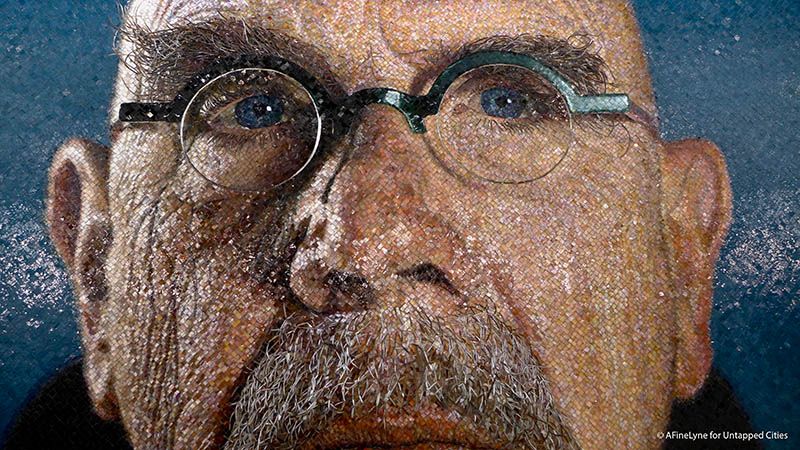 Self-portrait of renowned artist Chuck Close for the 86th Street Second Avenue Subway
Self-portrait of renowned artist Chuck Close for the 86th Street Second Avenue Subway
The much-anticipated first phase of the Second Avenue Subway, along with corresponding artwork, opened to the public on January 1st. Four renowned artists were chosen for each of the four stations running from 63rd Street to 96th Street. The artist Jean Shin at 63rd Street, with her work entitled “Elevated”; Brazilian artist Vic Muniz at 72nd Street, with his series entitled “Perfect Strangers”; Chuck Close at 86th Street, with his “Subway Portraits,” and Sarah Sze, (who recently visited The Studio in a School at 96th Street, later in this article) with “Blueprint for a Landscape.” See more images of the artwork.
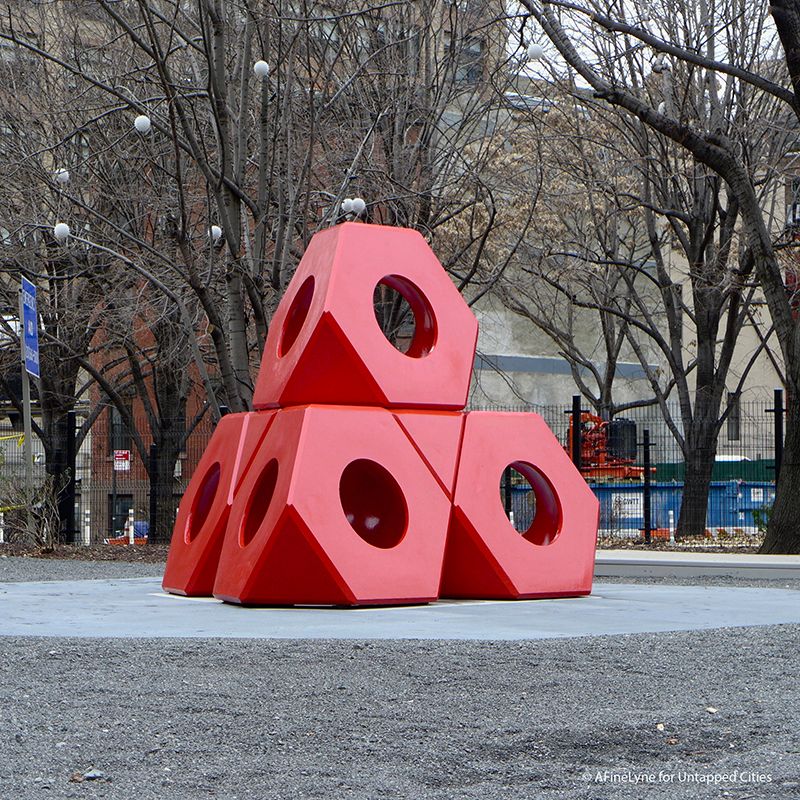
Isamu Noguchi “Octetra” at the entrance to the Holland Tunnel
An abstract work by renowned artist Isamu Noguchi has been installed in Freeman Plaza East, which is part of Hudson Square, at the Manhattan entrance to the Holland Tunnel. The piece entitled “Octetra” is seven feet high, and consists of five, four-sided triangular pyramids. It is presented by the Hudson Square Connection, and the Port Authority of New York and New Jersey, and is part of the Julie and Edward Minskoff collection. You can view “Octetra” in Freeman Plaza East, at the corner of Varick Street and Watts Street. Its length of stay has not yet been confirmed.
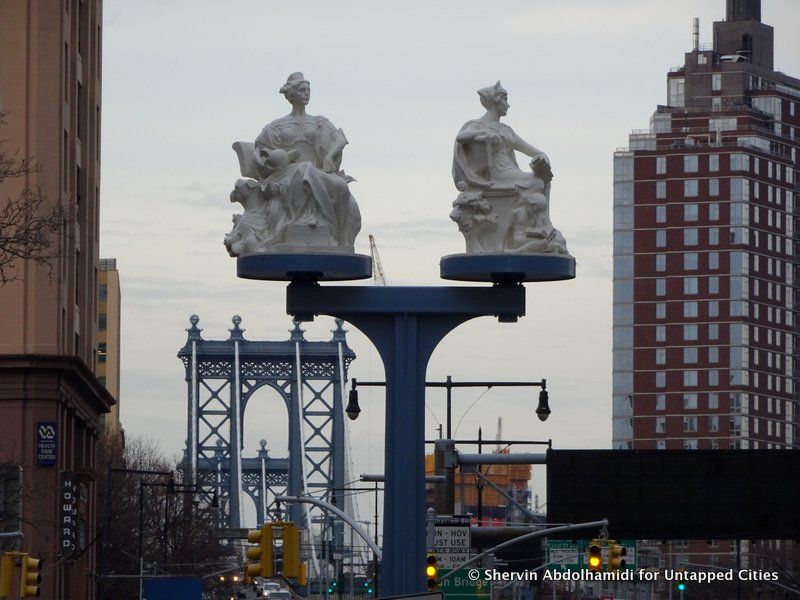
The Ladies have a storied history of standing at the entrance to the Manhattan Bridge, on the Brooklyn side, for fifty years, until Robert Moses took them down in the 1960s. The original Miss Brooklyn and Miss Manhattan, created by sculpture artist Daniel Chester French, now stand outside the Brooklyn Museum. Miss Brooklyn and Miss Manhattan have been brought back to life on the Brooklyn side of the Manhattan Bridge thanks to the City’s Percent for Art Program, and underwritten by the Economic Development Corporation. At a project cost of $450,000, the project was initiated ten years ago, with a design competition. The winner of the competition, artist Brian Tolle, who created among other installations, The Irish Hunger Memorial, gave his interpretation of the ladies some delightful additions, such as LED lighting to illuminate the sculptures from within at night, and placing them on top of a twenty-four foot pillar, allowing them to rotate.
Ringing in the New Year, Times Square Arts, Midnight Moment, was created by the Swiss artist, Pipilotti Rist, well-known for her single channel videos. This video installation entitled “Open My Glade (Flatten)” was originally commissioned by The Public Art Fund in 2000, when it was seen on a single screen in Times Square. The new, multichannel edition of the video surrounds the plazas on multiple screens, in vivid color, with Pipilotti’s face flattened against the glass, as if about to break through the screens into Times Square. The image brings ever closer to the viewer her message of transgressing expectations for women in media, and the invisible boundaries placed on women. “Open My Glade (Flatten)” will be on view from 11:57 pm to midnight, every night in January, 2017. Be sure to also check out Pipilotti Rist: Pixel Forest at The New Museum through January 15, 2017.
Nona Faustine’s solo exhibit “My Country” investigates the history of slaves and immigrants in their contributions to a Country “built upon their backs” through beautiful, thought provoking photography. Faustine connects the past and present using self portraiture, alongside national monuments to “underscore the history of ostracized Americans” with the use of the black female body. In this way, she hopes to evoke a critical and emotional understanding of our past, as well as evoking an understanding of racial and gender stereotypes. The exhibit is organized as a dialogue between past and present, and the viewer will find Faustine both behind and in front of the camera. The exhibit “My Country” will be on view through January 14, 2017 at Baxter Street Camera Club, located at 126 Baxter Street.
February 19, 2017 will mark the 75th anniversary of Executive Order 9066 – the wartime directive that authorized the internment of Japanese citizens and American citizens of Japanese heritage living on the West Coast. The artist, Isamu Noguchi was living in New York at the time, making him exempt from internment. However, his desire as a Japanese-American citizen to contribute to the “forcibly displaced community of Japanese Americans” led him to voluntarily enter the Poston War Relocation Center in the Arizona Desert, “Thus I willfully became part of humanity uprooted. “His hope was to remake the camp into a more humane environment, by adding such familiar amenities as swimming pools, baseball fields, and the like. After two months, it became clear that he would receive no support from the authorities who originally backed his ideas, and he prepared to leave. However it would ultimately take seven months before he could leave the camp.
The exhibit “Self-Interned, 1942: Noguchi in Poston War Relocation Center” curated by Noguchi Museum Senior Curator, Dakin Hart, brings together two dozen works taken from the Museum’s collection, that date back before, during and after Noguchi’s time at Poston, from 1941 to 1944. The later works clearly show the impact that Noguchi’s time at Poston had on his art. In addition, a substantial selection of archival documents are included in the exhibit, including blueprints showing the proposed improvements he hoped to make at Poston, and a design for a cemetery. Published articles on the unrest in the camps, and related documents and letters are also on view.
Self-Interned, 1942: Noguchi in Poston War Relocation Center will be on view from January 18, 2017 to January 7, 2018. The Noguchi Museum is located at 9-01 33rd Road, at Vernon Boulevard, in Long Island City. Read more in the book The Life of Isamu Noguchi: Journey Without Borders.
The exhibit Insecurities: Tracing Displacement and Shelter at the Museum of Modern Art is part of Citizens and Borders, a series related to works in the collection offering a critical perspective on histories of migration, territory, and displacement. Considering that United Nations figures suggest that 65 million individuals worldwide are refugees, asylum seekers, and displaced persons, shelters have been redefined as no longer temporary, since many are living in permanent upheaval today. Although the exhibit’s focus is in light of global refugee emergency shelter, it can also be considered to be relevant right here at home, as we work through various ways to deal with homelessness. The exhibit addresses how we understand housing, and bring together projects by architects, designers, and artists. This includes the jointly-designed IKEA Foundation-UNHR-Better Shelter modular emergency structure, along with works by Studio Teddy Cruz, Henk Wildschut, and Tiffany Chung, among others.
Also of interest is the exhibit How Should we Live? Propositions for the Modern Interior, which explores environments, both domestic and retail, from the 1920s to the 1950s, by bringing together over 200 works drawn from MoMA’s Architecture and Design collection. How Should We Live? will be on view through April 23.
Insecurities: Tracing Displacement and Shelter will be on view through January 22, 2017. The Museum of Modern Art is located at 11 West 53rd Street.
The Cooper Hewitt, Smithsonian Design Museum, confronts the subject of textile waste in a current exhibit entitled Scraps: Fashion, Textiles, and Creative Reuse. With sustainability at the heart of the design process, the exhibit features the work of three designers, and more than forty works, exploring both the preservation of local craft traditions and new technologies, and the recycling process. The exhibit will take the viewer on a deep-dive into the very heart of the subject, from the environmental impact of textiles, and the industry, to where our unwanted clothes go, and how to reduce, reuse, recycle and minimize waste, offering design solutions.
Viewers can follow along and join in the conversation after leaving the exhibit with the blog series Scraps Stories, exploring sustainability in relation to this exhibit. Scraps: Fashion, Textiles, and Creative Reuse will be on view through April, 2017. The Cooper Hewitt, Smithsonian Design Museum is located at 2 East 91st Street, at Fifth Avenue
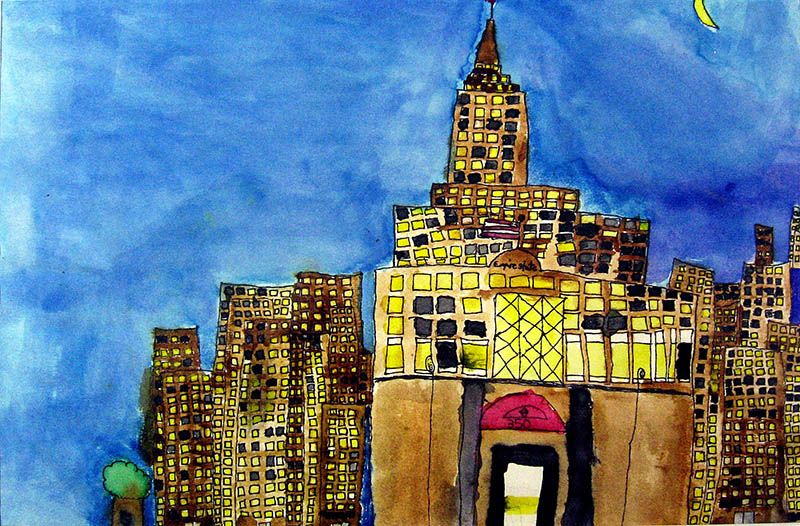
Samantha, Grade 4, P.S. 346, Brooklyn, Studio Artist Instructor: Jo Beth Ravitz.
Studio in a School was founded in 1977 as a creative educational initiative for underserved public schools from daycare centers to public schools within New York City’s five boroughs. It was founded at a time of financial crisis in our city, when art budgets were being reduced or eliminated throughout the public school system. Since then, the program has touched more than 850,000 children in more than 170 public schools, bringing more than 90 professional artists to participate in programs with the students. The exhibit “The City and the Young Imagination – Art from Studio in a School” explores the 40-year history of one of New York City’s most creative arts education initiatives, and features student works in watercolors, drawings, collages, and sculpture. The exhibit opens on January 14 at The Museum of the City of New York, located at 1220 Fifth Avenue, at 103rd Street.
Check out The Bridge and Tunnel event series, presented in collaboration with the Maysles Documentary Center, “Smile, It’s Your Close Up: New York Documentaries on January 25.
Also on tap from MCNY, “Zoning for Public Good” as part of Events: Talks, and presented in collaboration with the Municipal Art Society, on January 26.
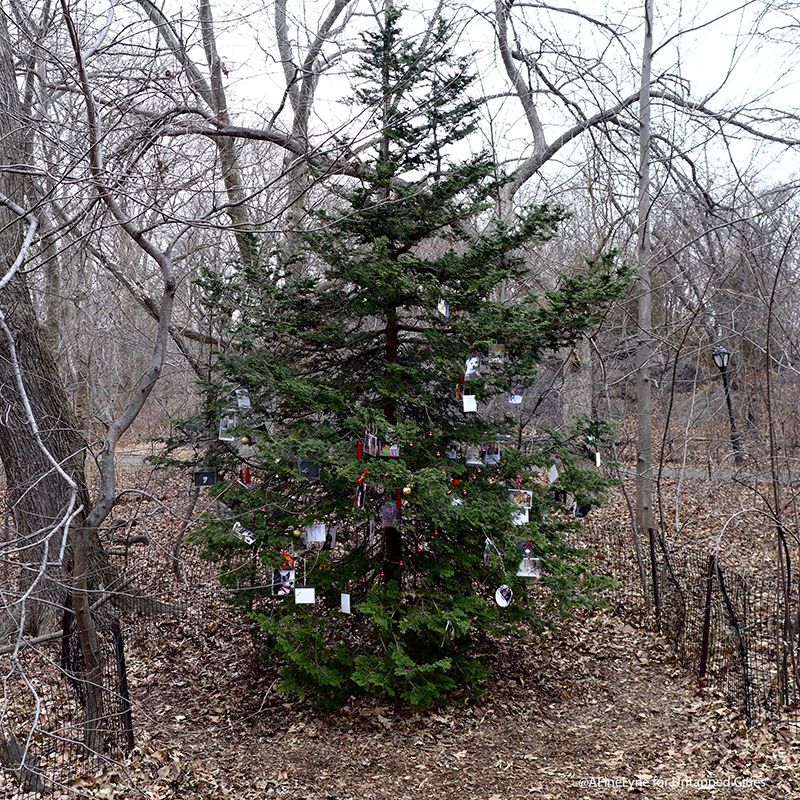
The Holiday Tree dedicated to pets, located in Central Park this year
Ever since we discovered this special memorial Holiday tree for departed pets a few years ago, each December we trek along the trails, deep into Central Park, to pay a visit and reflect on our own pets, now long gone. As in the past, we found our tree ladened with laminated ornaments with photo’s of beloved dogs, and this year, nestled among the pine needles – the addition of a beloved cat ornament! No one seemed to mind. We usually find a few owners, with their new pets at the site, but this year the tree stood alone, with an occasional treker, surprised by one lone decorated tree, alongside a Central Park path. While the location is a secret, we can say that the secret Holiday tree, dedicated to departed pets, will come alive again next year – same time, same place.
You still have time to visit The Dumbo Archway, The Holiday Train Show, and Kerry James Marshall: Mastry at Met Breuer. Check out New York at its Core and the return of The Cube at Astor Place, or take a Public Art Walking Tour in Lower Manhattan. Check out the art installations and exhibits we recommended in December. You can contact the author at AFineLyne.
Subscribe to our newsletter